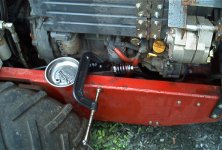Charlie_Iliff
Veteran Member
- Joined
- Jun 13, 2001
- Messages
- 1,890
- Location
- Arnold, MD
- Tractor
- Power Trac PT1845, John Deere 2240, John Deere 950, John Deere 755, Jacobsen Turf Cat II
Rip said:He may be refering to the machined aluminum "shuttle valve" that is unique to and probably made by PT. If so, not related to Brake Tender. Others (Charlie Iliff? Sedgewick? others?) have had problems with this item.... search postings past year or so. It is a tricky (to be polite) item!
If I were using for business, this is one case where I would get a complete new unit from PT and keep a spare on the shelf.
Good Luck
I've had leak problems only at the tank plates, which I fixed with good gasket glue, one steering hose that the end came off, and a diesel return hose that leaked at a fitting. That's in something over 5 years, but I certainly don't use it as much as Altavista's commercial operation. And, with rare exceptions, I'm the only operator.
